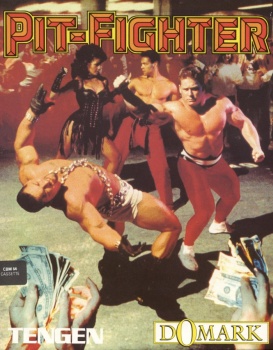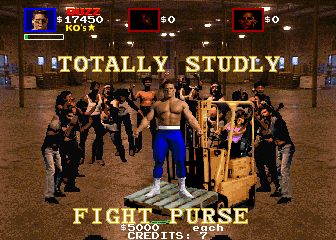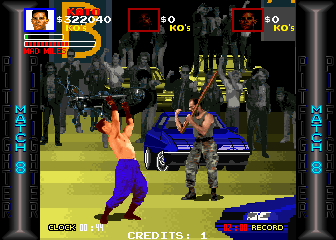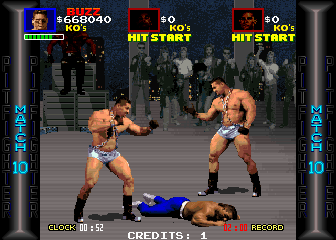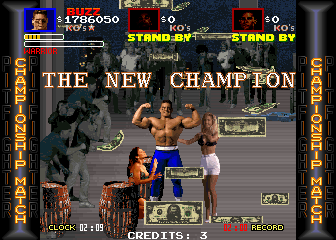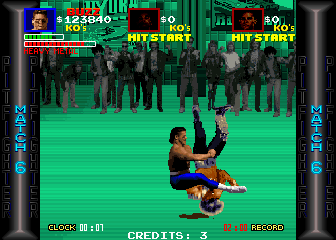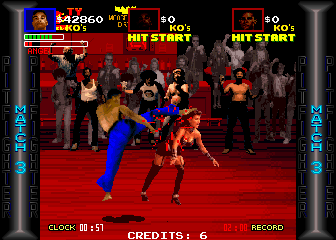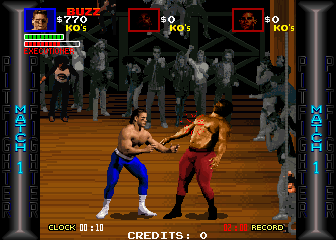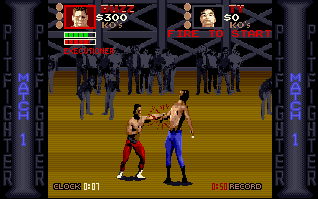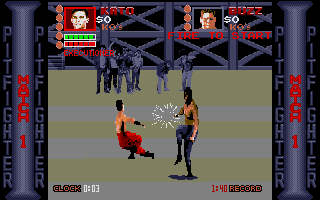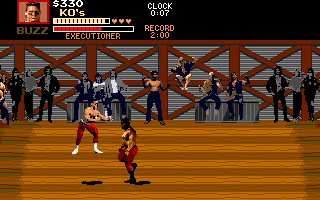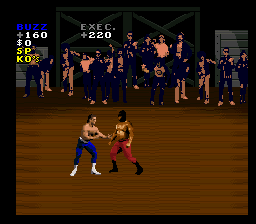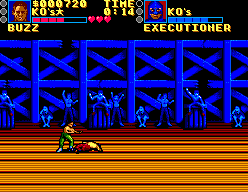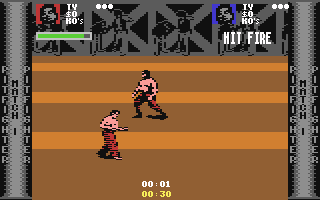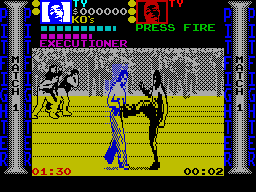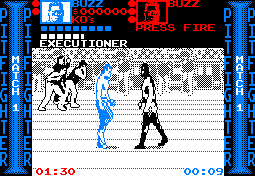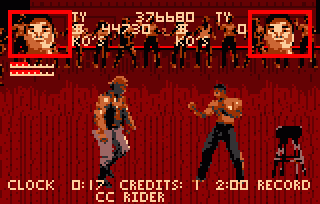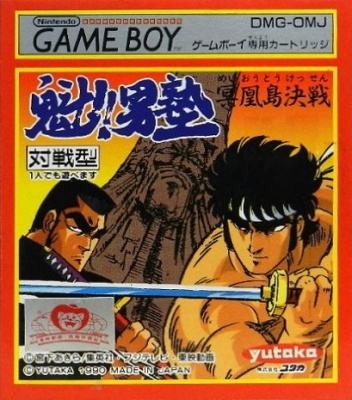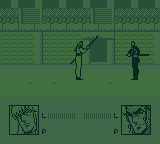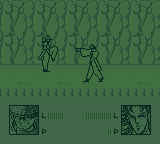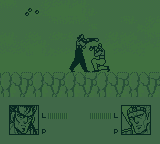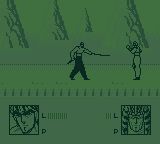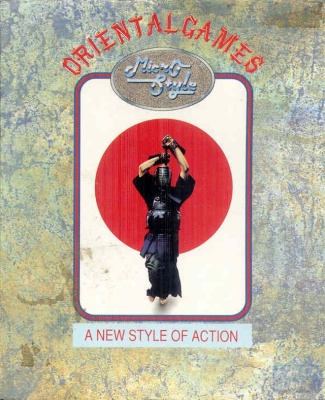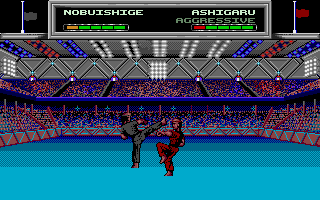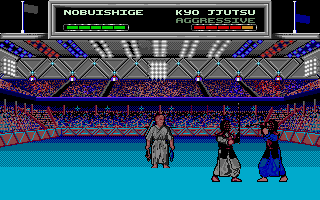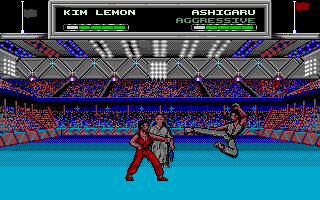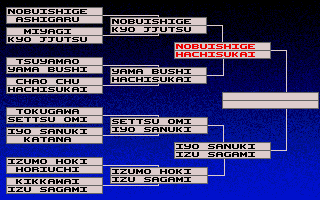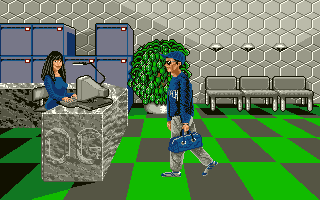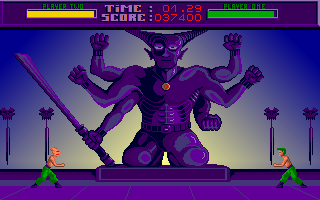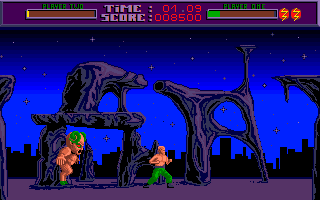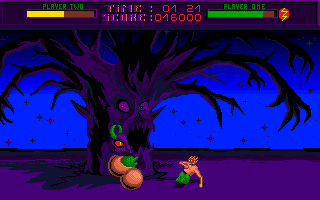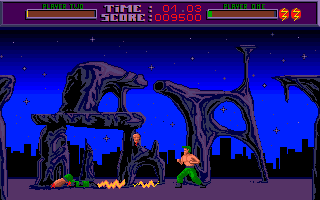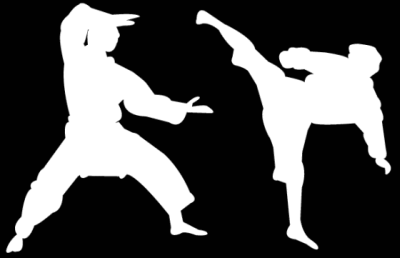
Pre-Street Fighter II Fighting Games
|
Page 1: |
Page 2: |
Page 3: |
Page 4: |
Page 5: |
|
Page 6: |
Page 7: |
Page 8: |
Page 9: |
Page 10: |
|
Page 11: |
Page 12: |
Pit-Fighter - Arcade, SNES, Genesis, Game Boy, Master System, Commodore 64, IBM PC, Lynx, Amiga, Amstrad CPC, ZX Spectrum, Atari ST, GameCube, PlayStation 2, Xbox, Windows (1990)
Pit-Fighter is probably the most well known fighting game in America to have been released prior to Street Fighter II. The game is remembered not for its quality, though, but for being mind-bogglingly horrible. Pit-Fighter might lack certain gameplay elements most other games have, but that isn't enough to explain why this game is so bad. As opposed to other better executed games, in Pit-Fighter every individual element is horribly executed. The hit detection is horrible, the control response is horrible, and the way the game simply feels is horrible. There are plenty of games that fail on every level and are really nothing more than boring. Pit-Fighter is another beast entirely, though. Pit-Fighter exceeds boring or bad and reaches that level where a game, despite giving people something to do, is infinitely worse than doing nothing at all.
The difficulty level is very high as it is, and the poor hit detection and controls just make players work that much harder to get anything to happen. Even when progress through the game is being made, it's all so poorly designed that there's so sense of achievement whatsoever. Its high level of challenge and technical problems also mean that absolute attention is required for even the actions that should, as a rule, be effortless to execute in a fighting game. This all combines to make Pit-Fighter a terrible chore to play, and among the few examples of a game that's actually more boring to play than to watch in action.
Most people quickly realize how bad this game is and don't bother to play past the first level. As bad as the designs are for the playable characters and the first boss, it gets worse. The character designs are insane, but the gameplay makes it impossible to enjoy any camp appeal. Thematically, Pit-Fighter is really not based on other fighting games, or even on other video games. At least not as much as it is based on bad 1980s B-level martial arts action movies - those kind of movies where the title is always a variation on "Kick Boxer" or "Bloodsport." The plot in those movies is always the same: a street fighter needs to get revenge on his brother's killer, and the only way to do so is to enter a secret tournament where guys fight in the middle of a circle of cars with their headlights on and women with teased hair sit on the hoods with fists pumping and yell "yeah!" Where every male character wears pants and no shirt, or a tank and sweats. Pit-Fighter is that kind of movie only in video game form. Change "get revenge on his brother's killer" to "win cash" and that is pretty much it. It even has has the generic "pit arena" in the early levels, and then the circle of cars in later levels. The screaming spectators are here as well.
There are three buttons, used for kicking, jumping, and punching. When pressing all three at the same time, the player character executes a special attack. There are a few interesting ideas here that were taken from beat-em-ups. There are occasionally weapons on the ground (like motorcycles!) that the player can attack with. Sometimes even spectators attack the player. Characters can walk into the crowd, but will get shoved back out by crowd members. There are also "Grudge Matches". During these, the goal is to knock down the opponent(s) three times, though loosing these doesn't end the game. Certain enemies have to be fought twice during the course of the game, and Chainman Eddie is fought along with a clone of himself in the level before the final boss. These differences from standard fighters do nothing to save the gameplay, though.
The game's real innovation is bringing three player co-operative play to the fighter genre (although the game plays more like a beat-em-up than anything else). Three players can team up to defeat the game's humorously badly designed boss characters. That's right, up to three people can be bored out of their minds at the same time.
Believe it or not, the ports are all much worse in every respect, though the Atari ST and Amiga versions are the most accurate. Even Nintendo Power once said that the SNES port of Pit-Fighter was the worst game ever released for a Nintendo console. Years later it was released as part of the compilation Midway Arcade Treasures 2 for Game Cube, PlayStation 2, and Xbox, and in 2006 for Windows PCs on Midway Arcade Treasures Deluxe Edition. These were straight ports of the arcade release, although the PlayStation 2 version has the timing all screwed up. A port for the Atari 7800 was made, but never released.
Comparison Screenshots
Sakigake!! Otoko Juku is another anime/manga adaption. After starting the game, players face off against a series of opponents who generally have weapons. The main character has a staff, but others have swords and whips. There's even a mummy at one point. There are story related scenes between fights, but of course they're all in Japanese.
There is only one single attack available, along with the ability to duck and jump very high. The game doesn't really innovate in any respect. However, certain levels have platforms that can be jumped onto. This feature really only allows players to pointlessly avoid their opponent and only makes matches drag on. Regardless of which type of arena the fight takes place in, the AI opponents jump around constantly, avoiding getting hit. The computer completely refuses to play aggressively, so more or less the entire game is spent striking at the air, trying to catch them every once in a while. The game also has poor hit detection, so it's difficult to find anything enjoyable here. It's only worth noting for being one earliest handheld fighting games.
Oriental Games is a multi martial arts competition like Budokan, albeit a bit more diverse. It is most notable for including the obscure discipline Kyokushinkai. Kyokushin is a full contact form of karate, much more brutal and tougher than what is usually seen in fighting games, and to the layman almost resembles Thai boxing. The other two disciplines are "kung fu" (no specification for the style is given) and kendo.
All three disciplines are controlled in Exploding Fist manner, where kendo as usual has a wider range of defensive stances. Sadly, responsiveness and hit detection are not quite up to snuff. Oriental Games has the same problem as Chambers of Shaolin with blows that hardly ever connect. Despite the conservative sports competition makeup, fights are always decided by health instead of points. The health bar consists of only five notches, but they turn from green to grey, orange and red in succession, so actually a lot more hits are required to win. (The 8-bit versions use a more ordinary, slowly recharging health bar.)
The original versions of this game are on the Amiga and Atari ST, but it was also ported to the Amstrad CPC and ZX Spectrum. A Commodore 64 version is strangely missing this time. The 8-bit versions only allow 4 players to enter a tournament as opposed to the original's 16 and of course they don't look and sound as good. The disciplines also have to be played in order, whereas they can be selected from a menu on the Amiga/ST. but they make up for the cutbacks with the addition of a fourth sport, which is also very rare in Western-developed games: sumo wrestling. The discipline isn't represented very well, though: First, it's hard to even get into a grapple because the CPU always tries to run into the player, and then most struggles just end with one of the combatants falling down, because actually executing a throw is too complex. They also get an unique background for each discipline instead of the uniform stadium of the original.
Oriental Games (Amstrad CPC)
Quick Info:
|
Developer: |
|
|
Publisher: |
|
|
Genre: |
|
|
Themes: |
Oriental Games (Amiga)
Oriental Games (Amiga)
Oriental Games (Amiga)
Additional Screenshots
No Exit is not the first fighting game from France - see the screenshot for Loriciels' terrible C64 game Bob Winner on the final page - but it's the first that's worth highlighting at all. It's not for good quality, mind you, but at least it has some redeeming features. For starters, it has one of the greatest loading screen messages, second only to Virtua Fighter Remix' "Patience, grasshopper!"
The controls are as simple as in a beat-em-up, but No Exit is extremely fast and feels much better than it actually is for it. Unfortunately, the high speed also means that everything succumbs into hectic button mashing quite easily. At the beginning, the player gets to chose the main character's strengths on a chart between strength/efficiency and vivacity/resistance, whatever most of that means. The fighting takes place in a nightmarish dimension, and the player appears to be some kind of demon, who can transform into another monstrosity in each stage. It also has some very brutal death animations, where the loser is hacked into pieces. The enemies all have the same torso as the hero, though, only with their own, ghastly deformed heads.
No Exit (IBM PC)
Quick Info:
|
Developer: |
|
|
Publisher: |
|
|
Genre: |
|
|
Themes: |
No Exit (Amiga)
No Exit (Amiga)
No Exit (Amiga)
Panza Kick Boxing / Best of the Best: Championship Karate / The Kick Boxing (ザ・キックボクシング) - Amiga, Atari ST, IBM PC, Amstrad CPC, TurboGrafx-16, NES, Game Boy, Genesis, SNES (1990)
Another French production, Panza Kick Boxing takes a more down-to-earth approach than No Exit and presents itself as a serious sports simulation. Great effort was taken to have realistic kick boxing moves in the game. At the time of its release, Panza Kick Boxing had the most expansive moveset in the entire genre - at least in theory. There are 55 different attacks in the game, but in between fights you have to chose 13 of them to map to the typical simple directions or directions plus button press. Being the last notable single-button home computer fighting game to predate Street Fighter II, it is therefore also the best example to show the limitations of this dead-end approach. As the manual tried to justify the method:
Technically, we could have given you direct access to all 55 blows but that would mean very complex combinations of the positions of the joystick. So to make things easy, we chose the simple and easy to use solution.
This limitation to 13 blows allows an immediate access to the technique you want to use, that means more rapidity and precision in your performance.
Panza Kick Boxing (Atari ST)
Panza Kick Boxing certainly is more strategic than most of its ilk, though, and there's a fairly long learning curve to figure out the reach and hit boxes of each move. It's not the best balanced, though. Some moves almost seem useless, while others completely destroy the AI almost every time, but going against a human player can become quite interesting.
All fights are set in a big stadium, either a properly lit and fully populated one to evoke a big sports event, or bright and empty for a training round. The fighters' health is represented by the spotlights in each upper corner, which get knocked out as the respective combatant grows weaker and weaker. It's not a straight downward spiral, though, as the kick boxers also recover a bit in between rounds and when they can prevent getting hit for a while. If someone does get knocked down, he's counted out and has a chance to get up again, which usually works out once or twice in a match. The amount of rounds for the fight can be determined in the options menu - from a relaxed three to exhausting twelve rounds.
The game tries to convey a bit of a career feel in between the fight. You go up against ever stronger opponents, who all have different heads in the options menu, but look just the same in the actual game. If the difference in abilities is too high between the opponents, however, the game won't let them fight each other, so you first have to get some training to tackle the strongest champions and snatch their titles. The training program involves rope skipping, done by quickly jerking the joystick between left and right, a poorly explained weightlifting unit and a reaction test where targets spring forward at three different heights, and you quickly have to press a direction to hit them. The latter test is the only one that works out reliably, though, so usually it's faster to boost up resistence, strength and reflexes by fighting weaker opponents multiple times.
Panza Kick Boxing was released under that title for the IBM PC, Atari ST, Amiga and Amstrad CPC, and as André Panza Kick Boxing for the TurboGrafx-16. The 16-bit versions are more or less identical aside from different color palette limitations, but the Amstrad drops the training aspect. The game received an update in 1992, which was strangely renamed Best of the Best: Championship Karate, even though all the moves in the game are still the same, and the computer versions still read "Panza Gold Edition" in small letters below the new title. The biggest differences are a new roster of opponents with more varied menu faces and the omission of the empty stadium variant. At least the Amstrad CPC now got training lessons, too.
Best of the Best had a much farther reach than the original, as it was ported to all major game consoles at the time. The NES and Game Boy versions replace the training disciplines with some more generic variations on the target kicking and don't allow to freely configure the moves - you're limited to predetermined sets instead. The Genesis and SNES retain the free mixing of techniques, but make practically no use of the many more buttons available to players on these consoles - a major missed opportunity, as the SNES could have supported almost all moves at once (it's not that well documented whether the Genesis' six-button pad was released before or after the game). The 16-bit consoles also introduce some cool new training rounds, where you get to work a heavy bag and do some sparring in the gym. Of course, all these versions came out much later than Street Fighter II, but since it's still essentially the same game as Panza Kick Boxing, there is not Street Fighter DNA in them.
Comparison Screenshots
|
Page 1: |
Page 2: |
Page 3: |
Page 4: |
Page 5: |
|
Page 6: |
Page 7: |
Page 8: |
Page 9: |
Page 10: |
|
Page 11: |
Page 12: |

